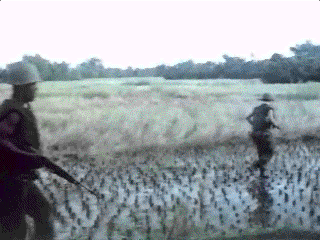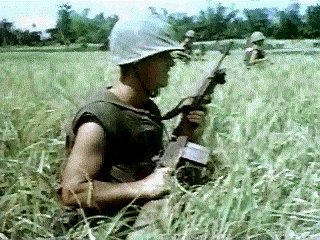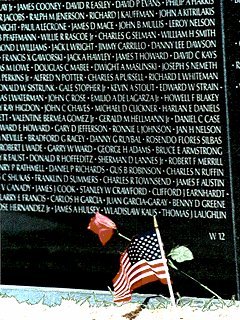


There were four countries that were divided during the
years after World War II as the result of global Communist strategy: China,
Germany, Korea, and Vietnam. Until formal reunification in 1976, Vietnam was
split at the 17th parallel of latitude into North Vietnam, with a Communist
government, and South Vietnam, with a republican government. Much of Vietnam
had been controlled by France for over a century as part of French Indochina.
Following World War II a bloody seven-and-a-half-year struggle raged between
Communist Vietnamese and the French for control of the land. Finally a peace
conference was held at Geneva, Switzerland, to determine the fate of
Indochina. Concluding in July 1954, the conference determined that French rule
would be ended in Vietnam and that the country would be temporarily divided
politically. Neighboring Laos and Cambodia, comprising the rest of Indochina,
were prohibited from making military alliances. Foreign military bases were
barred from their territory and from Vietnam. (See also Cambodia; Laos;
Indochina.)


Rebels Raid South Vietnam

Not long after the 1954 partition, United States military
advisers assumed the task of training the South Vietnamese army. At the same
time, Ho Chi Minh, president of North Vietnam, pledged to "liberate"
South Vietnam. Communist guerrillas, known as the Viet Cong, infiltrated
across the border and by way of Laos in large numbers, supplementing bands of
native Communist terrorists in the south. A chief objective of these rebels
who were directly controlled by the Vietminh, North Vietnam's governing
faction was to disrupt South Vietnamese social and economic improvement
programs. The assassination of local administrators was one of the ways in
which guerrillas sought to bring this about. Guerrilla bands also raided
industrial plants, plantations, military installations, and entire villages.
Frequently they attacked at night, withdrawing afterward to the security of
the forest. Seldom were the South Vietnamese forces able to fight them in the
open. The struggle in Vietnam was never concentrated along a single front.
Patches and strips of Communist-held territory spread gradually across the map
of South Vietnam. By 1965 much of the coastline and nearly all borderlands had
fallen to the rebels. Most of the Mekong Delta, Vietnam's vital rice-growing
area, had also been seized.

South Vietnam Government Loses Support

Rebel gains coincided with the waning popularity of South Vietnam's president,
Ngo Dinh Diem. Elected in 1955, Diem enjoyed great popularity at first, but
public support, as well as that of military officers and cabinet ministers,
gradually disappeared. This stemmed largely from the fact that Diem's brother
and closest adviser, Ngo Dinh Nhu, was able to manipulate officers and
military units at his discretion. Madame Ngo Dinh Nhu, Diem's bitterly
outspoken sister-in-law, also played a unique and important role in arousing
the disfavor of Vietnamese and foreigners alike. In October 1961 President
John F. Kennedy sent his military adviser, Gen. Maxwell D. Taylor, to South
Vietnam to evaluate that country's economic and military condition. General
Taylor reported that infiltration of the Viet Cong from the north was
increasing, that South Vietnam's economy had suffered drastically, and that
better and more equipment was needed. American aid was stepped up. During the
next two years more than 16,000 military advisers were sent to South Vietnam,
and some 400 million dollars was provided in military aid alone. For the time
being, Viet Cong successes were halted. A serious setback occurred in May
1963, when President Diem, a Roman Catholic, prohibited the flying of the
Buddhist flag. Thousands of Buddhists were arrested, and some were tortered or
killed. Buddhist priests publicly burned themselves to death in protest;
national morale was badly shaken. The Viet Cong attacked with greater fervor.
Casualties and desertions from the South Vietnamese army rose sharply as
public displeasure with the Diem regime mounted. In early November, barely
three weeks before President Kennedy was killed in Dallas, Diem and Nhu were
assassinated. A military junta assumed control. The government remained
unstable, however, with a marked absence of popular support.

United States Warships Attacked

On Aug. 2, 1964, the United States was drawn further into the conflict when
the USS Maddox, a destroyer cruising in the Gulf of Tonkin, was attacked by
North Vietnamese patrol boats 30 miles off the coast of North Vietnam. Two
days later the Maddox and another destroyer were attacked; two North
Vietnamese patrol boats were sunk by return fire. President Lyndon B. Johnson
ordered retaliatory air attacks. The continuing instability of the Vietnamese
government made United States assistance more difficult. Coups, attempted
coups, or government shake-ups occurred almost monthly. The State Department
warned that unless Vietnamese army officers kept out of politics, American aid
might be discontinued. Mass demonstrations by Buddhist groups alternated with
those of Catholics, depending upon which of these groups was in power at the
time. Terrorist attacks upon American installations in South Vietnam became
frequent. These were calculated to discourage the United States into complete
withdrawal from Vietnam. Their immediate effect, however, was to increase the
tempo of air raids by American aircraft against North Vietnam. Principal
targets were highways and bridges. In neighboring Laos, bombers also struck
the Ho Chi Minh Trail, an important Viet Cong supply line. United States
warships shelled North Vietnamese coastal installations.

Peace Bids; Civil War Threatens

In April 1965 President Johnson proposed that "unconditional
discussions" be held for a settlement of the conflict. His peace move was
ignored by North Vietnam. The North Vietnamese insisted that United States
forces first be withdrawn from South Vietnam. They also stipulated that the
United Nations must not intervene and that the internal affairs of South
Vietnam would have to be settled in accordance with the program of the
National Liberation Front, the political arm of the Viet Cong. Johnson
maintained that these matters could not be discussed prior to a peace
conference. In June he urged the United Nations to seek a solution. An era of
relative stability in South Vietnam's government began in June when a new
military regime was installed. The new regime was led by a ten-man military
junta, which called itself the National Leadership Committee. Air Force
Commander Vice-Marshal Nguyen Cao Ky, a member of the council, was named
premier. Ky's first crisis in office followed his dismissal of Lieut. Gen.
Nguyen Chanh Thi in March 1966 from the military council and from his post as
a regional army commander. Thi had established himself as virtual warlord of
several provinces in northern South Vietnam. He had also aligned himself with
politically powerful Buddhists, including Thich Tri Quang. When followers of
General Thi publicly protested his dismissal, Tri Quang encouraged further
antigovernment demonstrations. The Buddhists demanded that civilians be
represented on the governing council and that elections be held for a national
assembly. Civil war threatened as fighting erupted between government forces
and troops loyal to Thi. Riots instigated by the Buddhists, notably Tri Quang,
broke out in Saigon, Hue, and Da Nang. Again, as in 1963 Buddhists publicly
burned themselves to death. In April Premier Ky acceded to most of the
Buddhist demands; elections were scheduled for later in the year. The unrest
continued, however, as militant Buddhists called for Ky's resignation.
Meanwhile government troops won back control of the cities which had been
taken over by Thi's followers. By mid-1966 the rioting had also subsided.


United States Role Accelerates

During 1965 the United States became even more deeply committed to South
Vietnam's struggle for freedom. In February it was officially revealed that
planes raiding North Vietnam were being flown by American personnel. In June
it was acknowledged that United States troops were engaged in combat with the
Viet Cong. By midyear the size of the United States force in South Vietnam
exceeded 50,000 troops, having doubled in less than six months. Although
contingents had also arrived from South Korea, Australia, and New Zealand, the
military situation in South Vietnam continued to deteriorate. Military
observers theorized that 1965 was the year scheduled by the Communists for
total victory. With the approach of the summer rainy season and an anticipated
Viet Cong offensive, Ky asked for more American ground forces. Between July
and November a fighting force of an additional 100,000 men was transferred
from military bases in the United States to Vietnam. The first major American
victory took place in August at Chu Lai, where more than 5,000 United States
troops defeated an estimated 2,000 Viet Cong. In November American forces won
a decisive victory over a large North Vietnamese force in the Ia Drang Valley.
It was the first time that a major Viet Cong or North Vietnamese force had
abandoned hit-and-run guerrilla tactics for open combat. Ia Drang was the
bloodiest battle of the war to that date. In January 1966 some 20,000
American, South Vietnamese, and South Korean troops encircled four enemy
regiments south of Da Nang. A successful allied sweep through the central
coastal province of Binh Dinh took place in the spring. In February 1965
United States bombers attacked North Vietnam in retaliation for a Viet Cong
raid on the United States helicopter base at Plei Ku. The Viet Cong bombing
raids continued, however. In May the air strikes against the North were
suspended for five days, following President Johnson's invitation in April to
"unconditional discussions" of peace. The raids were again suspended
in late December 1965 and throughout January 1966 as a so-called "peace
offensive" was launched by President Johnson and other world leaders. The
North Vietnamese failed to respond to these overtures. In June 1966 United
States bombers made their first attack on the industrial outskirts of North
Vietnam's two largest cities Hanoi, the capital, and Haiphong, the chief port.
Subsequent American bombing raids were made on these as well as other
industrial centers and on MiG air bases in North Vietnam. United States forces
increased from 190,000 in January 1966 to more than 500,000 by early 1968 used
"search-and-destroy" tactics to expel National Liberation Front (NLF)
forces from the South. In 1967 and 1968, American troops raided NLF troop
concentrations in the demilitarized zone. In January 1968 the NLF launched a
large-scale offensive throughout the South during Tet, the Vietnamese Lunar
New Year holiday. The targets included about 30 provincial capitals. On March
31 President Johnson faced with increasing antiwar sentiment announced a halt
in all bombing north of the 20th parallel and offered to negotiate for peace
with North Vietnam. Peace talks began in Paris in May, but were quickly
deadlocked. After the United States stopped bombing North Vietnam in early
November, the North Vietnamese agreed not to escalate the war. In January 1969
South Vietnam and the NLF joined the talks. On April 29, 1970, American and
South Vietnamese ground forces began an assault on North Vietnamese and NLF
sanctuaries in Cambodia. Months later, similar action was taken by the South
Vietnamese on targets in Cambodia and Laos in 1971. (In 1973 the United States
government reluctantly admitted that it had conducted secret bombing missions
inside Cambodia in 1969, and in Laos in 1970.) American troop withdrawals,
which had begun in the summer of 1969, left fewer than 200,000 Americans in
South Vietnam at the end of 1971. In April 1972 the United States bombed
civilian dwellings and military targets in the cities of Hanoi and Haiphong.
In May of that year, in response to a drive by the North Vietnamese forces
into the South, President Richard M. Nixon ordered the mining of harbors off
North Vietnam. Both the bombing and the mining provoked sustained antiwar
protests within the United States.

The End of the Conflict

On Jan. 27, 1973, a cease-fire was signed in Paris by the United States, South
Vietnam, North Vietnam, and the Provisional Revolutionary Government of the
NLF. A Four-Party Joint Military Commission was set up to implement such
provisions as the withdrawal of foreign troops and the release of prisoners.
An International Commission of Control and Supervision was established to
oversee the cease-fire. United States ground troops left Vietnam by the end of
March 1973. Fighting continued, however, as the North and the South accused
each other of truce violations. A second cease-fire was signed in June, but
the hostilities continued through 1974. The ultimate fall of South Vietnam
began with the capture of Phuoc Long Province in January 1975. Soon more
inland provinces were under North Vietnamese control and the major coastal
cities had fallen, with little resistance from Southern troops. The war in
Cambodia ended on April 16, and the South surrendered on April 30, 1975, as
enemy troops entered Saigon. (See also Vietnam; Ho Chi Minh.)

Excerpted from Compton's New Century Encyclopedia and
Reference
Collection II Copyright (c) 1995 Compton's NewMedia, Inc.


|
All graphics and
pages are copyright © 1997 - 2008 Pages 4 Ever
(except where noted). Do not take, copy, steal, plagiarize or use in any
way, shape or format without the express written permission of Pages
4 Ever.
Some backgrounds and graphics made from clipart acquired from ArtToday, Boxed Art,
friends, my own imagination, and/or
graphic CD collections that I have purchased. If you find anything on this site
that you have copyright to, and can prove it, please let me know and I will
gladly either remove it or place a link back to you, whichever you prefer.
If you should find any broken links, please drop us a line and let us know the
exact URL the broken link is on. Thank you.
|

|
![]()
![]()



